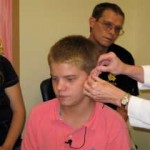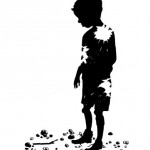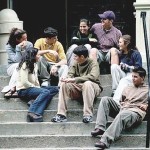 He wins a scholarship for a speech-aid device.
He wins a scholarship for a speech-aid device.
By Dan Scanlan
Matthew Reid is a 13-year-old whose 2-year-old stepbrother, Aidyn, is dealing with cancer.
If that’s not enough, Matthew stutters, making him the target of school bullying, he admits.
But thanks to eloquent words he wrote about his life with stuttering, his spoken words now flow more easily. Matthew’s essay won a SpeechEasy Sean Anderson Scholarship. And a tiny hearing aid-like device was presented to him Wednesday at Wolfson Children’s Rehabilitation Services in Jacksonville.
He called that “pretty sweet.”
“I actually feel pretty excited and it just feels awesome,” Matthew said after a few minutes of steady speech with the device.
“His stuttering had gotten so bad everybody was getting a bit aggravated,” said his mother, Dora Reid. “It is so different to actually have a conversation with him. … I can’t ask for a better blessing, with the exception of healing Aidyn. This is a blessing beyond words.”
Matthew is a tall teen with two older sisters and his stepbrother who live in Waverly, Ga., with Dora and Mark Reid. His stuttering lengthens and sometimes stalls words. Home-schooled for three years due to bullying and Aidyn’s medical issues, he had to stop speech therapy when his stepbrother was diagnosed with germ cell cancer and underwent nine chemotherapies, 25 radiation treatments and 11 surgeries.
He admitted that school with a stutter was very tough, so he couldn’t wait for the device so he could go back to class as an eighth-grader.
“Every other week, this one kid would try to pick fights, but that’s just how he is,” Matthew said. “I want to just talk a little bit smoother and just hope people would stop making fun.”
The road to SpeechEasy started when the Wolfson staff noticed Matthew’s stuttering when he was there visiting Aidyn and arranged an evaluation. He was urged to write an essay about how stuttering affected his life, which won the scholarship.
Started by Ocoee residents Andy Anderson and Martha Lopez-Anderson, the scholarship provides free SpeechEasy devices and therapy to children who stutter. It is named in memory of their 10-year-old son Sean, who received the device nine months before his death in early 2004.
Looking like a hearing aid, the $4,700 SpeechEasy mimics what is called the choral speech effect. That’s when stutterers improve when they talk, sing or read with other people, said Judy Hammer-Knisely, the speech pathologist who evaluated him.
“The stutterer thinks someone else is speaking with them,” she said.
Hammer-Knisely placed the device in his left ear Wednesday and asked his mother to help with simple exercises.
“How do you think this is going to help you with your brother?” Dora Reid asked.
“It will help a lot because I wouldn’t want him to try and talk like I do,” he answered.
Lopez-Anderson said she had happy memories as she held her late son’s photograph through Matthew’s first session.
“I see the same progress and the same improvement I saw in my son,” she said with tears in her eyes. “A child should have an opportunity, besides speech therapy, to have an improvement in their stuttering, anything that will give them the tools to not withdraw.”
This is the fourth year a child served by Wolfson rehab has received the Florida scholarship.
















